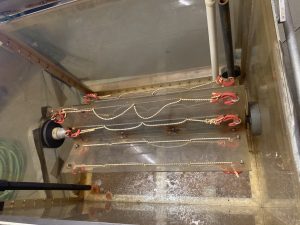The wheel is a-turning!
This week I got another chance to dive into the Biology Department warehouse. I’m working on a proposal that would include controlled feeding experiments with copepods. To get accurate and consistent measurements, it’s important to make sure all the food particles don’t sink to the bottom of the experimental containers. This can be done by slowly rotating the bottles throughout the experiment on a “plankton wheel.” It turns out that the department has one! Apparently it was built “back in the day” for Anne Sell, who was a postdoc with Larry Madin at the time. Phil Alatalo (the same miracle worker who materialized Holger Jannasch’s Winogradsky columns for me) was able to find the crate with the wheel inside it, but testing it was a two person job. On Tuesday we submitted our daily health surveys, donned our protective masks and ventured into the warehouse. We hefted off the heavy wooden cover, and saw a big plexiglass box that contained the wheel connected to a motor. The “wheel” (in the picture) is formed from two intersecting sheets of plexiglass with cords that can be used to secure bottles to the structure. The photo shows the view looking down into the box, and we hoped that the wheel would rotate around the horizontal metal axle. We dug out the power cord, held our breaths (a bit) and plugged it in. Sure enough the wheel began to turn at about 1 rpm….a good speed for keeping the plankton guessing which end is up (i.e., not sinking). I’m excited to re-purpose a nice piece of custom equipment and hope we get the chance (i.e. funding) to do these experiments!
consistent measurements, it’s important to make sure all the food particles don’t sink to the bottom of the experimental containers. This can be done by slowly rotating the bottles throughout the experiment on a “plankton wheel.” It turns out that the department has one! Apparently it was built “back in the day” for Anne Sell, who was a postdoc with Larry Madin at the time. Phil Alatalo (the same miracle worker who materialized Holger Jannasch’s Winogradsky columns for me) was able to find the crate with the wheel inside it, but testing it was a two person job. On Tuesday we submitted our daily health surveys, donned our protective masks and ventured into the warehouse. We hefted off the heavy wooden cover, and saw a big plexiglass box that contained the wheel connected to a motor. The “wheel” (in the picture) is formed from two intersecting sheets of plexiglass with cords that can be used to secure bottles to the structure. The photo shows the view looking down into the box, and we hoped that the wheel would rotate around the horizontal metal axle. We dug out the power cord, held our breaths (a bit) and plugged it in. Sure enough the wheel began to turn at about 1 rpm….a good speed for keeping the plankton guessing which end is up (i.e., not sinking). I’m excited to re-purpose a nice piece of custom equipment and hope we get the chance (i.e. funding) to do these experiments!